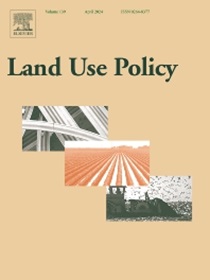通过远耦合分析中国土地利用和贸易驱动的土地流转
IF 5.9
1区 社会学
Q1 ENVIRONMENTAL STUDIES
引用次数: 0
摘要
通过区域间相互作用的视角了解土地利用动态对于在日益相互联系的世界中实现可持续的领土发展至关重要。然而,现有的研究大多局限于行政单位,未能系统地解释土地消费与生产之间的空间脱钩。采用多区域投入产出(MRIO)模型与结构分解分析(SDA)相结合的方法,研究2002 - 2017年中国土地利用的时空特征及其驱动力。通过构建经济部门和土地利用类别之间的详细映射,我们追踪了嵌入国内贸易的土地流动的强度、方向和规模。区域间土地流转比例从2002年的22.3% %显著上升至2017年的57.4% %,表明对地方以外土地资源的依赖日益增加。结果表明,中国土地足迹总量大幅增加的同时,土地利用效率和区域依存度的差异加剧。沿海省份通过消费驱动的需求越来越依赖外部土地,而内陆地区通过资源和土地密集型生产成为土地净出口国。供应方面的技术改进大大降低了土地利用强度;然而,经济增长的扩张性效应和最终需求的结构性转变盖过了这些影响。本研究在方法上的贡献是加强了远耦合框架,将虚拟土地流动纳入国内贸易,从而提供了对超出行政边界的土地利用动态的更细致的理解。研究结果为优化土地资源空间配置和指导中国及其他快速城市化经济体的差别化土地治理提供了政策见解。本文章由计算机程序翻译,如有差异,请以英文原文为准。
Unpacking China's land use and trade-driven land transfers through telecoupling
Understanding land use dynamics through the lens of interregional interactions is critical to achieving sustainable territorial development in an increasingly interconnected world. However, most existing studies remain confined to administrative units, failing to systematically account for the spatial decoupling between land consumption and production. This study integrates a multi-regional input-output (MRIO) model with structural decomposition analysis (SDA) to investigate the spatiotemporal characteristics and driving forces of land use in China from 2002 to 2017. By constructing a detailed mapping between economic sectors and land use categories, we trace the intensity, direction, and scale of land flows embedded in domestic trade. The share of interregional land transfers rose markedly from 22.3 % in 2002 to 57.4 % in 2017, revealing a growing reliance on extra-local land resources. The results demonstrate that while China's total land footprint expanded substantially, disparities in land use efficiency and regional dependency have intensified. Coastal provinces increasingly depend on external land through consumption-driven demand, while inland regions serve as net land exporters via resource- and land-intensive production. Technological improvements on the supply side significantly reduced land-use intensity; however, they were outweighed by the expansionary effects of economic growth and structural shifts in final demand. This study contributes methodologically by enhancing the telecoupling framework to incorporate virtual land flows within domestic trade, thereby providing a more nuanced understanding of land use dynamics that extend beyond administrative boundaries. The findings offer policy insights into optimizing the spatial allocation of land resources and guiding differentiated land governance in China and other rapidly urbanizing economies.
求助全文
通过发布文献求助,成功后即可免费获取论文全文。
去求助
来源期刊

Land Use Policy
ENVIRONMENTAL STUDIES-
CiteScore
13.70
自引率
8.50%
发文量
553
期刊介绍:
Land Use Policy is an international and interdisciplinary journal concerned with the social, economic, political, legal, physical and planning aspects of urban and rural land use.
Land Use Policy examines issues in geography, agriculture, forestry, irrigation, environmental conservation, housing, urban development and transport in both developed and developing countries through major refereed articles and shorter viewpoint pieces.
 求助内容:
求助内容: 应助结果提醒方式:
应助结果提醒方式:


